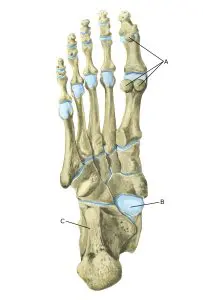Anatomy
 In several places on the foot, small cartilage bones (ossa sesamoidea) are embedded in tendons and ligaments. The sesamoid bones protect the tendons and ligaments from strain. There are almost always 2 sesamoid bones embedded in the flexor tendon of the big toe (musculus flexor hallucis brevis) under the metatarsophalangeal joint.
In several places on the foot, small cartilage bones (ossa sesamoidea) are embedded in tendons and ligaments. The sesamoid bones protect the tendons and ligaments from strain. There are almost always 2 sesamoid bones embedded in the flexor tendon of the big toe (musculus flexor hallucis brevis) under the metatarsophalangeal joint.
The foot from below.
A. Ossa sesamoidea
B. Talus
C. Calcaneus
Cause of the problem
Sesamoiditis is a term used to describe the ‘inflammation’ of the 2 small cartilage bones (sesamoid bones) and surrounding soft tissue structures under the base joint of the big toe (1st metatarsophalangeal joint, MTP-1).
The pain can have several causes, including inflammation, bone fractures (avascular bone necrosis) and sesamoid bone fractures, which can occur acutely after a sudden heavy load or in the form of fatigue fractures after repetitive repetitive stress (running). Sesamoiditis is a common condition and accounts for 2% of all foot injuries and 18% of all big toe injuries in athletes.
Symptoms
Sudden or slow onset of pain under the metatarsophalangeal joint of the big toe with aggravation when running, jumping and when the big toe bends backwards (extends).
Examination
The diagnosis is made by clinical examination by the relevant professional. Imaging (X-ray, ultrasound or MRI scan) is often necessary in addition.
Treatment
Treatment includes primary relief from pain-inducing activity with slowly increasing load within the pain threshold. It is recommended that shoes with stiff soles are used, possibly with a hinged sole. If there is inflammation in and around the sessile bones and relief is not successful, you can try to supplement with medical treatment in the form of arthritis pills (NSAIDs) or ultrasound-guided injection of adrenal cortex hormone around the sessile bones.
In complex cases with sesamoid fractures or persistent discomfort despite relief and medical treatment, surgery may be indicated.
Rehabilitation, specific:
Exercise within the pain threshold is permitted. Fitness can be maintained by cycling and swimming. Guidelines during rehabilitation are generally followed.
Complications
However, if the progress is not smooth, you should consider whether the diagnosis is correct or if there are complications:
In particular, the following should be considered:
- Arthritis disease of the big toe joint,
- Plantar plate lesion under the big toe
- Bone fracture
- Stiff toe syndrome (hallux rigidus)
- Tendon synovitis
